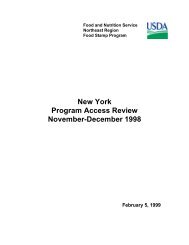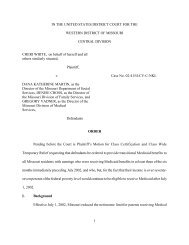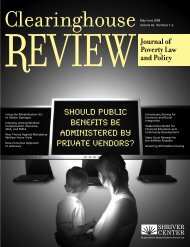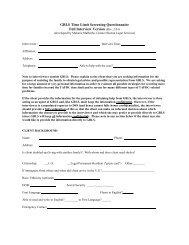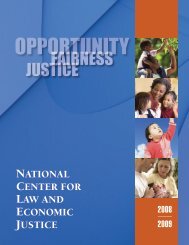The Role of the Courts in Securing Welfare Rights and ...
The Role of the Courts in Securing Welfare Rights and ...
The Role of the Courts in Securing Welfare Rights and ...
Create successful ePaper yourself
Turn your PDF publications into a flip-book with our unique Google optimized e-Paper software.
<strong>Welfare</strong> Law Center· Workers’ Compensation - Many states have <strong>in</strong>corporated workers’ compensationprotections directly <strong>in</strong>to <strong>the</strong>ir workfare statutes. In addition, several important court decisionshave held that workfare workers are covered by workers’ compensation protections. 43· Health <strong>and</strong> Safety Protections - Some states legislatively provide that workfareworkers are entitled to <strong>the</strong> exact same protections as regular workers. For example, New YorkState now provides that workfare workers must be provided <strong>the</strong> exact same coverage under <strong>the</strong>New York Public Employee Health <strong>and</strong> Safety Act as regular public employees. In o<strong>the</strong>rsituations, protections may be secured under <strong>the</strong> federal Occupational Health <strong>and</strong> Safety Act(OSHA). However, one should be aware OSHA protections do not extend to persons work<strong>in</strong>gfor public employers such as state, county, or local agencies. In most <strong>in</strong>stances where <strong>the</strong>re areextensive federal or state statutory health <strong>and</strong> safety protections, violations can only be pursuedby mak<strong>in</strong>g a compla<strong>in</strong>t to <strong>the</strong> agencies charged with enforcement.Resort to litigation may provide some relief to welfare recipients exposed to horrendouswork<strong>in</strong>g conditions <strong>in</strong> o<strong>the</strong>r situations. Two court decisions <strong>in</strong> this area are <strong>in</strong>structive. InCapers v. Giuliani, a class <strong>of</strong> workfare workers assigned to street clean<strong>in</strong>g duties <strong>in</strong> New YorkCity challenged <strong>the</strong> lack <strong>of</strong> adequate work place health <strong>and</strong> safety protections under state welfarelaw provisions requir<strong>in</strong>g workfare placements to be made only to sites that comply with workerprotection requirements. <strong>The</strong> pla<strong>in</strong>tiffs claimed that <strong>the</strong>y were denied access to 1) toilets,wash<strong>in</strong>g facilities, <strong>and</strong> dr<strong>in</strong>k<strong>in</strong>g water; 2) personal protective equipment; 3) traffic safetyequipment; <strong>and</strong> 4) tra<strong>in</strong><strong>in</strong>g <strong>and</strong> supervision. In August 1997, <strong>the</strong> Capers court certified a class<strong>and</strong> entered a prelim<strong>in</strong>ary <strong>in</strong>junction enjo<strong>in</strong><strong>in</strong>g assignment <strong>of</strong> any class member to a workfareassignment until <strong>the</strong> City provides necessary health <strong>and</strong> safety protections, <strong>in</strong>clud<strong>in</strong>g access totoilets <strong>and</strong> potable water, gloves <strong>and</strong> face masks, <strong>and</strong> tra<strong>in</strong><strong>in</strong>g regard<strong>in</strong>g potential worksitehazards. However, <strong>the</strong> order was vacated after <strong>the</strong> state passed legislation extended publicemployee workplace protections to workfare workers. 44In Ramos v. County <strong>of</strong> Madera, 45 <strong>the</strong> California Supreme Court held that AFDCrecipients, assigned to pick crops <strong>in</strong> exchange for <strong>the</strong>ir benefits, could challenge <strong>the</strong> violation <strong>of</strong>May 1999⋅ 18 ⋅




